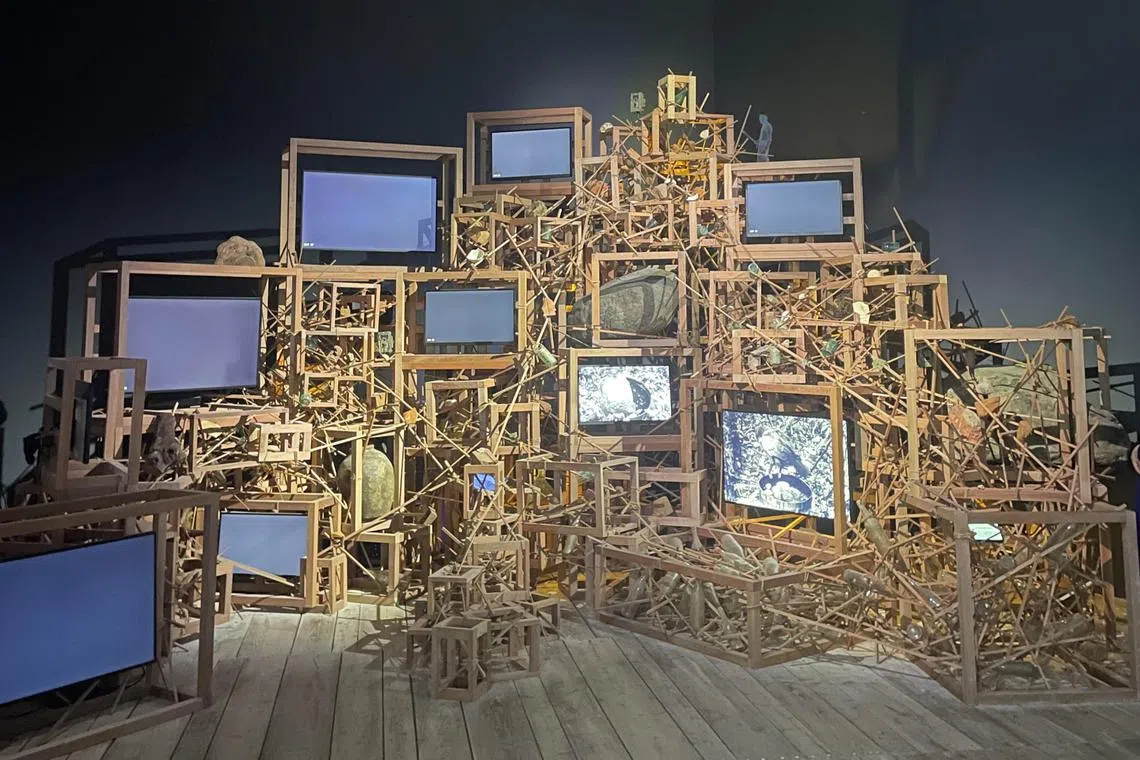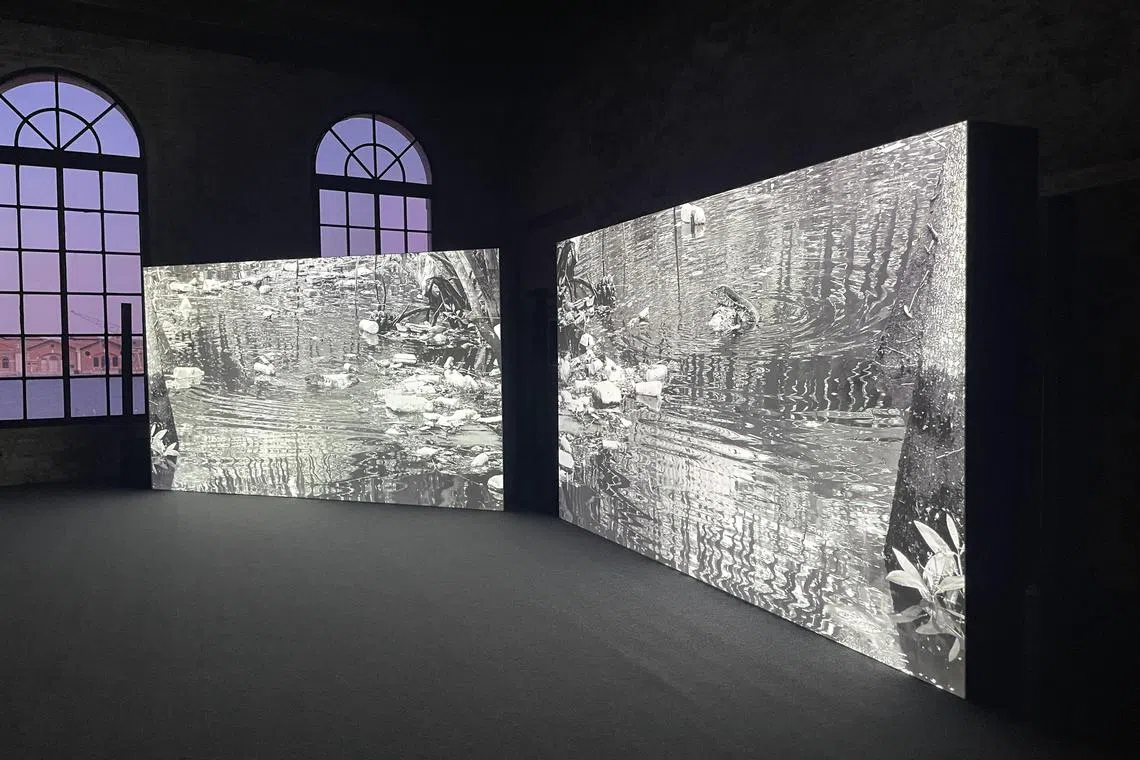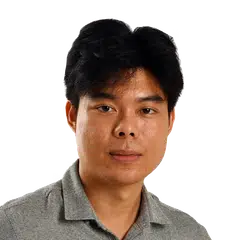Biggest Singapore representation in history at 60th Venice Biennale
Sign up now: Get ST's newsletters delivered to your inbox

Robert Zhao's installation Trash Stratum at the Venice Biennale.
ST PHOTO: CLEMENT YONG
Follow topic:
VENICE – Supposedly extinct Sambar deer loitering around the Bukit Timah Expressway (BKE). A colony of parrots coming home to roost on a particular tree in Choa Chu Kang. Monitor lizards mating and making use of a container left by migrant workers as a watering hole.
These are some of the passed-over stories captured by artist Robert Zhao on film over his more than eight years studying secondary forests in Singapore. They are on show at the Singapore Pavilion in Venice, at the “Olympics of art” Venice Biennale, which attracts 500,000 visitors each edition and will officially open to the international public on April 20.
Organised by the Singapore Art Museum (SAM) and commissioned by the National Arts Council (NAC), Zhao’s solo exhibition
Broadening the theme Stranieri Ovunque, or Foreigners Everywhere, Zhao, like many of his counterparts, have sought to explore it along the veins of ecology.
His show, which he worked on with SAM curator Haeju Kim, is mainly sited in a dark space created from tinted windows and opaque partitions.
It comprises three works: a two-channel, 46-minute video installation telling 10 segmented stories of how the urban blends into the natural in Singapore; a lattice structure embedded with screens and found glass objects; and a digital print of a buffy fish owl. This is a species of owl in Singapore that has found a way to exist by feasting on catfish in drains, rather than survive in its usual pristine environments.
Zhao, 41, says of his obsession with the interaction between man and nature: “It’s very obvious the secondary forest is a foreign place. It’s a mix of native and introduced species. Because they are untended spaces, anything that can thrive can survive.
“There’s a balance that they strike themselves. They balance themselves out with nobody’s help.”
Secondary forests have emerged in Singapore after the removal of the earlier primary forest. They often contain remnants of human activities, occupying a liminal space in which Zhao has found particular fertility.
In one of the sections, a wild boar uses a trash bag that Zhao had previously photographed to make a nest when she gives birth to her cubs.
Zhao’s five-year-old son, Noah, got involved in the project by looking at live feeds from the cameras Zhao installed around the sites, and alerting him to exceptional happenings so Zhao could rush down to the scene, which is close to their 26th-floor Housing Board flat in Bukit Panjang overlooking the BKE.
Zhao says: “Most of the time, these spaces are quite boring. If I were to walk into a forest for a week I would probably see nothing, but in times like these, it’s very natural and rewarding.”
Asked if eight years is enough time spent on a subject for him to move on, he says: “I want to walk away, but I can’t. It’s an obsession or addiction. Even for this, I had to cut down the original film by half. I’m not in control of the stories the forest throws up.”

Robert Zhao’s The Owl, The Travellers And The Cement Drain at the Singapore Pavilion.
ST PHOTO: CLEMENT YONG
The Singapore Pavilion is a 250 sq m space the Singapore Government signed a 20-year lease for in 2015. Previous artists showcased at the Venice Biennale include Zai Kuning, Song-Ming Ang and Shubigi Rao.
2024’s Singapore presence is the strongest ever in Venice. Eight works by South-east Asian artists in the National Gallery Singapore’s collection are included in the main exhibition of the 60th International Art Exhibition at the Giardini, the other centre of activity at the biennale.
It is the first time Singapore has paintings from its collection included at the prestigious venue. They include portraits by Nanyang artists Georgette Chen, Lim Mu Hue and Chua Mia Tee, and Indonesian heavyweight Affandi and Vietnam’s Le Pho.
Senior curator and director of curatorial and collections at the National Gallery Singapore Horikawa Lisa says this shows Venice Biennale curator Adriano Pedrosa’s recognition of modernities beyond that of Europe and America.
“Through these portraits, the divergent paths to modernisms taken by artists from South-east Asia are illuminated.
“National Gallery Singapore articulates an approach to South-east Asian art history that seeks not to add the region’s artists to a so-called global canon, but instead to inflect and infect the very concept,” she says.
Minister of Culture, Community and Youth Edwin Tong, who is in Venice to open the Singapore Pavilion, says the Government is committed to providing opportunities for artists to show their works internationally.
This is Singapore’s 11th time participating at the Venice Biennale, after an interregnum in 2013 when the NAC briefly suspended representation due to cost concerns, a move later reversed after backlash from the community and re-evaluation.
He promises: “The Government will continue to do whatever it takes to support artists. We will continue to facilitate cultural exchanges between Singapore artists and the world through international partnerships, through memorandums of understanding, through residencies and other means.”


